01 Oct Video Conferencing Software Showdown: Zoom vs. GoToMeeting
Meetings are the lifeblood of most organizations. And video conferencing software makes it easier than ever for people to meet, communicate, and collaborate with their prospects, customers, and teams.
There’s no need to constantly travel to win new business or always be on site to complete projects with coworkers. Just log in to your video conferencing app, and move business forward virtually.
To help you determine which video conferencing app to choose for your business, we’re comparing two of the most popular providers: Zoom and GoToMeeting. Let’s dive in and see how they stack up.
Common Features and What We Looked For
As undeniable leaders in their category, Zoom and GoToMeeting each offer impressive features and benefits. Both apps are easily accessed with the app’s desktop and mobile apps, and participants can even join meetings using only their web browser—though they won’t have access to as many features.
As you read, consider what’s important to your business when it comes to online meetings and video conferencing. How many attendees will you typically need to accommodate? Do you want multiple video feeds visible on screen? Will you need screen sharing, annotation, group chat, breakout rooms, and other collaboration tools? Do you want to record your meetings, and if so, how much cloud storage might you need?
Our showdown focuses on the following areas. Click on the ones that are most important to your business—or jump straight to our feature comparison table.
- Video Conferencing Features
- Screen Sharing
- Annotation and Whiteboarding
- Group Chat and Breakout Rooms
- Web Audio, Dial-in, and Calling Options
- Design and Ease of Use
- Host and Admin Controls
- Recording, Transcripts, and Storage
- Plans and Pricing
Video Conferencing Features
Zoom has some unique features, while GoToMeeting’s settings are more technically advanced.
Both Zoom and GoToMeeting offer HD video, multiple video feeds, and multiple types of webcam views—e.g., full screen, just the presenter, a gallery view where you can see all participants sharing their webcams on screen at once, a view of just the person who’s speaking, and more. You can display up to 49 webcams at one time in your meeting with Zoom, and up to 25 with GoToMeeting. These features will more than suffice for most businesses.
That said, Zoom offers some unique video settings. The Touch up my appearance feature applies a softening filter akin to retouching in Photoshop—automatically in real time—which is great if you’re in an environment with harsh lighting (though it’s hard to tell the difference sometimes). It also has a virtual background feature that allows you to display a background image on a green screen (or similar) during your meeting.
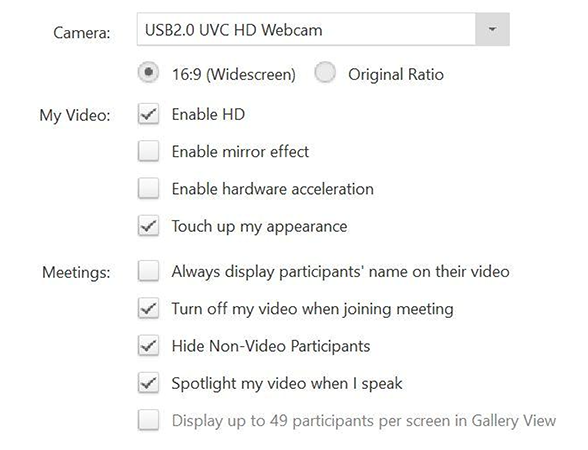
On the other hand, GoToMeeting offers a number of rich technical settings that Zoom doesn’t. These settings can be used by the meeting organizer to conveniently optimize their webcam’s visuals.

GoToMeeting’s video settings
Both providers offer top-notch, reliable performance. As long as your and your attendees’ internet connections are fast and solid, you should—generally speaking—have no connection or reliability problems with either app, regardless of meeting duration.
Screen Sharing
Zoom offers more advanced options for screen sharing.
Since screen sharing is a cornerstone of online group collaboration, it’s a make-or-break feature in video conferencing software. Zoom and GoToMeeting both offer robust and easy-to-use screen sharing functionality.
When you choose the screen sharing option in either app, you’re conveniently presented with options of all the windows and applications currently open on your device, and you can choose which to share. A window opens and displays your screen sharing options visually, and there’s an option in GoToMeeting to select them from a list in a dropdown menu as well. Both Zoom and GoToMeeting also offer keyboard and mouse sharing by the host and all participants, so no matter who’s sharing their screen, anyone with permission can control it.

Screen sharing options in GoToMeeting
With either app, there’s an option for the host alone to share their screen, or for the host to allow all participants to share their screens, one at a time, at the host’s discretion. Both apps also offer mobile app screen sharing so that you can share your iPhone/iPad or Android screens.
That said, Zoom’s advanced screen sharing features are outstanding. For example, you can share computer audio during screen sharing (e.g., share a streaming video with your computer’s audio). Or you can share just a portion of your screen, which comes in handy if you’re trying to home in on something specific on a page.
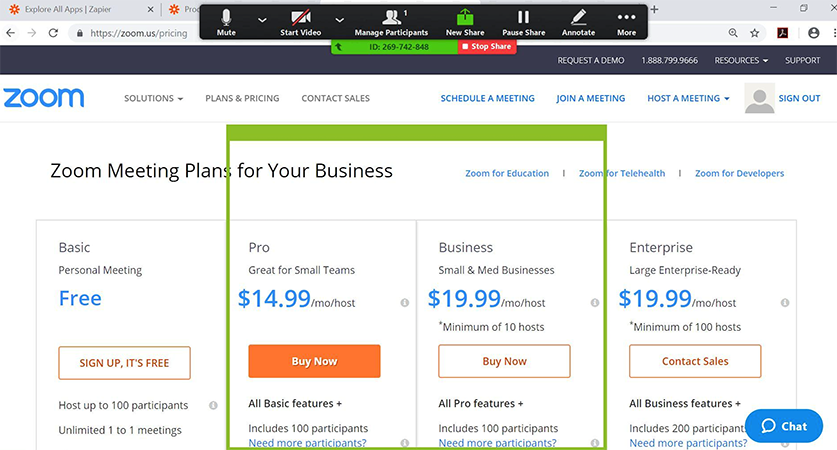
You can share a portion of your screen in Zoom.
Other unique Zoom screen sharing features include simultaneous screen sharing among multiple participants, dual monitor screen sharing, and iOS/Android document sharing.
Annotation and Whiteboarding,
Zoom offers more robust drawing tools and a unique whiteboarding option.
During an online presentation, attendees might find it helpful to be able point to, highlight, circle, and make comments on certain information on the screen for clarity and impact.
Zoom’s annotation and drawing tools are powerful, easy, and fun to use. You can point to, spotlight, or highlight an area. You can create text boxes with different font sizes and even bold or italicize your text, draw in thick lines or thin lines, and create all sorts of filled and unfilled shapes, while applying a wide palette of color choices to all of the above. You can even insert graphic elements like check marks and arrows and erase select areas that you’ve annotated.
Zoom also stands out with its whiteboarding option that makes brainstorming and project planning as seamless as being in a conference room with your team. And it’s easy to access: Click Share at the bottom of your video, and then select Whiteboard.
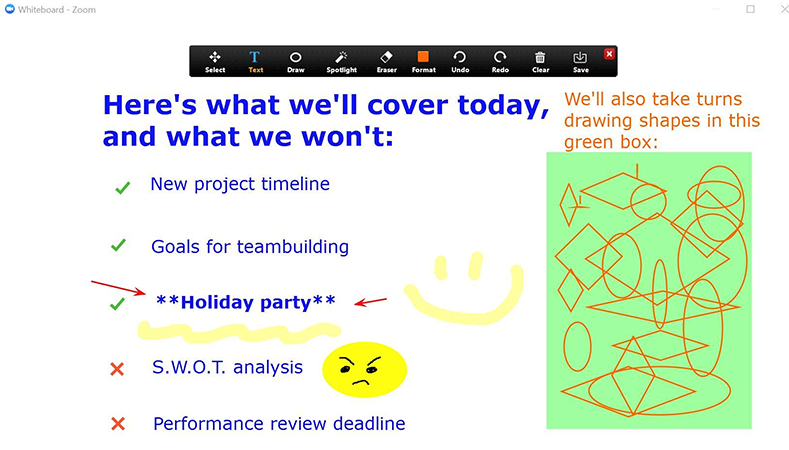
GoToMeeting also offers annotation, co-annotation, and drawing capabilities, but they’re significantly limited compared to Zoom. You can choose to annotate in different colors, but you can only point, highlight, or draw a thin line. You’re also only able to erase everything you’ve annotated versus just a select area.
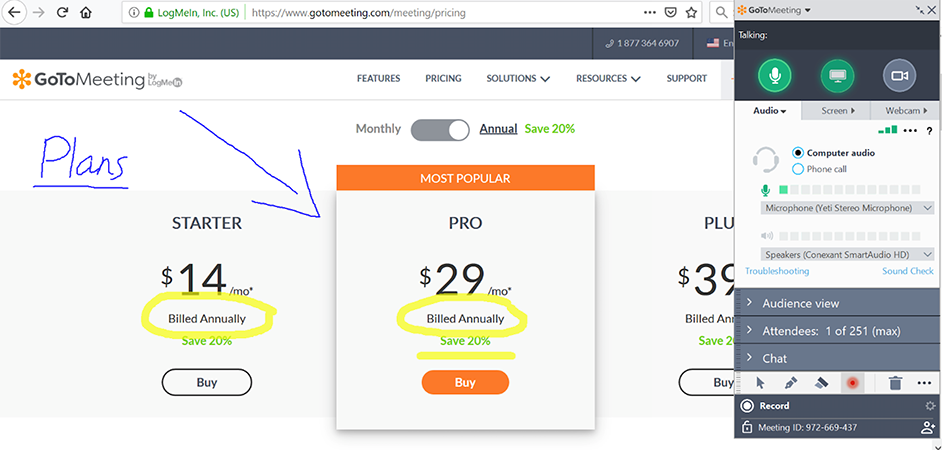
Annotating in GoToMeeting
So if all you need is basic annotation capacities, GoToMeeting will do the trick. But for more in-depth annotations or the use of a virtual whiteboard, you’ll need Zoom.
Group Chat and Breakout Rooms
Each offers comparable chat features, but Zoom also offers Breakout Rooms.
Group chats work similarly in Zoom and GoToMeeting. Once enabled by the host, a window appears where participants can type in their comments and questions and scroll through to see the chat thread. The chat feature is always on, with the ability to seamlessly flow into a meeting. In its latest update, Zoom now has a full text chat window, with support for sharing files and images, plus creating groups. If you and your team want one place for both video meetings and robust chat in one app, Zoom would be the option for you.
To help build and keep momentum going, Zoom and GoToMeeting also offer a group messaging feature that allows meeting participants to message each other before and after meetings, to share files when messaging, and to invite and message external users. These are true, standalone instant messenger apps that you can use while you’re in meetings to hold private group conversations outside the in-meeting chat boxes.
Zoom edges ahead with its Breakout Rooms feature that allows you to split your main meeting into up to 50 separate sub-meetings or sessions complete with audio and video. The meeting host(s) can choose to split the participants of the meeting into these separate sessions randomly or manually—and can jump into any of them or switch between sessions at any time. If you anticipate hosting large meetings with the need for small group breakouts, you’ll need to go with Zoom.
Web Audio, Dial-In, and Calling Options
GoToMeeting offers more flexible calling options.
Both Zoom and GoToMeeting offer high-quality web audio that makes it easy for meeting attendees to participate using their device’s microphone and speakers without having to dial in over the phone. Testing web audio is a bit easier and faster with Zoom: You can record a sample of yourself speaking into your microphone and play it back before you start the meeting.
When it comes to traditional phone calling options, all GoToMeeting and Zoom plans include dial-in long distance (toll) conference lines. They also both offer toll-free dialing and a Call Me feature for additional costs. With Call Me, participants don’t have to dial in: Zoom and GoToMeeting do the dialing for them by calling them at the scheduled meeting time.
Zoom’s Call Me feature is only available as part of an add-on audio package that also includes toll-free dialing for an added price of $100 per month. This package is only available for its Pro plans or higher. GoToMeeting, on the other hand, offers its Call Me feature at every plan level—and it’s not tied to the toll-free dialing option, which is a separate, additional cost.
So if your participants are most likely to use the phone to connect to your meetings (versus web audio), GoToMeeting has more flexible calling options.
Design and Ease of Use
Zoom’s interface is cleaner, making it easier to navigate for all users.
Both apps offer intuitive control panels and dashboards, but Zoom’s minimalist and straightforward user experience makes it more universally accessible.
For example, Zoom’s control panel is integrated into the main screen and appears as a thin black bar at either the bottom or top of the screen. You can easily toggle between all the meeting options—which are well spaced out and easy to see—by simply moving your mouse left to right. Plus, you can set the control panel to appear only when you place your mouse over it.

Zoom’s control panel
GoToMeeting’s controls, on the other hand, are static and always appear in a separate window next to the main screen. In the full-sized window view, GoToMeeting controls are stacked from top to bottom—and within that overall layout, they’re further arranged in a combination of left-to-right and top-to-bottom displays. It’s a noticeable difference from Zoom’s linear, left-to-right layout. But you can shrink the GoToMeeting controls so that they appear as a small group of controls at the top of the screen.
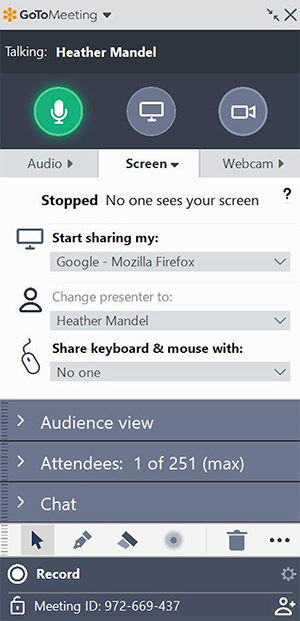
GoToMeeting control panel
For some GoToMeeting controls, you’ll use dropdown menus or right click on the control to see all the options. With Zoom, you can mostly point and click on a control, and a new window will open, visually presenting options for you to click on. When there are further options in Zoom, there are distinct arrows that indicate as much.
Host and Admin Controls
Both tools offer strong meeting control and security, but Zoom has more options.
Starting at each app’s most basic version or plan, a meeting host can control the participants’ audio by muting or unmuting it and controlling whether participants can unmute themselves. Hosts can control all participants’ video by showing or hiding webcams and controlling their screen sharing options. They can also allow attendees to chat with everyone or just the host.
At the Pro plan levels of each app, Zoom and GoToMeeting also include a feature that adds an extra layer of security to the meeting by making the attendees wait to be allowed in. GoToMeeting calls this Meeting Lock, and Zoom calls it Waiting Room.
In Zoom, if the meeting organizer selects Enable join before host for a personal meeting, the Require meeting password option is also enabled. This prevents unauthorized participants from fraudulently using the meeting ID by requiring them to enter a password. Zoom also allows hosts to put attendees on hold and temporarily remove attendees from the meeting.
With Zoom’s Pro plan, the user management feature allows account owners and admins to manage their users—including adding and deleting users and assigning roles. As the account administrator or owner, you also have advanced meeting controls such as enabling and disabling recording, encryption, chat, and notifications. Zoom even allows you to assign someone else to set up your meetings for you, although the assignee must also have a Zoom Pro plan.
Recording, Transcripts, and Storage
GoToMeeting offers unlimited cloud recording and storage.
Beginning with its free version, Zoom’s local recording feature lets you save your meeting recordings in .mp4 (video), .m4a (audio), and .txt (chat) formats to store on your device. Then, starting with Zoom’s Pro level, you’ll get 1GB of .mp4 or .m4a cloud recording. This allows you to record meetings in the Zoom Cloud, where the file can then be downloaded and/or streamed from a browser. In its Business plan and above, Zoom even offers auto-generated cloud transcripts. But if you want more than 1GB of storage, you’ll have to purchase it as an add-on starting at $40 per month.
GoToMeeting offers a clear advantage in that it provides unlimited cloud recordings, transcripts, and storage starting at its mid-level Pro plan. You can record and share your meetings locally or in the cloud, listen again, and share them. You can also easily search through and share automatic transcripts of your recorded meetings. So if you have frequent meetings that you want to record, GoToMeeting provides more value.
Pricing
Your needs will dictate which app provides more value.
If you’re looking for the most robust solution at the lowest price, Zoom appears to win—with caveats. Zoom charges add-on fees for extra attendees and cloud storage that you might end up needing. And with its higher-priced plans, Zoom has a minimum host requirement that GoToMeeting doesn’t have.
For example, Zoom’s Business plan is $19.99 per month per host, with a minimum requirement of 10 hosts—which ends up costing at least $199.90 per month. GoToMeeting’s lack of a minimum host requirement in its higher-priced plans may also provide a bargain compared to Zoom. It depends on your needs.
But if you don’t need more than 1 GB of storage and don’t need to accommodate more than 100 participants, Zoom’s Pro plan is probably the better value. It offers all the features of GoToMeeting’s comparable Pro plan—and more—for about half the cost.
One final note: Zoom offers a free plan, which GoToMeeting does not. Zoom even loads in most of its premium features in its free plan. The biggest drawback to the free version is its time limit on meetings: 40 minutes if you have three or more participants.
Zoom vs. GoToMeeting: Which App Should I Use?
Zoom and GoToMeeting are both industry-leading choices to meet any organization’s video conferencing needs. Both offer high-quality video and audio, along with robust group collaboration features needed to conduct smooth and productive online meetings.
If you’re just starting out or are a small-to-medium-sized business that only needs to accommodate up to 100 participants, Zoom can provide you with a fully-featured video conferencing solution for a lower price—or even no price depending on your needs. But if you’re a larger organization that regularly needs to accommodate 150 to 250 attendees and can benefit from unlimited cloud storage and a no-minimum-host requirement, GoToMeeting may end up being a better value for you.
Finally, here’s an at-a-glance feature comparison.
| Zoom | GoToMeeting | |
| Video Conferencing Features | “Touch up my appearance,” virtual background, and more | Technically advanced visual settings |
| Screen Sharing | Advanced options including simultaneous screen sharing | Basic screen sharing to meet most needs |
| Annotation and Whiteboarding | Robust annotation tools and whiteboarding feature | Basic annotation tools for screen sharing; no whiteboarding |
| Group Chat and Breakout Rooms | In-meeting chat, standalone group chat, and separate breakout rooms to promote deeper collaboration | In-meeting chat and standalone group chat |
| Web Audio, Dial-In, and Calling | Dial-in and calling options offered at various plan levels | Full dial-in and calling options including Call Me on every plan |
| Design and Ease of Use | Clean, with controls along the bottom of the screen | More complex control panel, separate from screen |
| Host and Admin Controls | Advanced host and admin controls for various features | Basic controls that ensure meeting control and security |
| Recording, Transcripts, and Storage | Multiple recording features, but cloud storage above 1 GB costs extra | Multiple recording formats and unlimited cloud recording and storage at Pro plan level and above |
| Pricing | Free version provides full features and Pro plan may be the best deal | No free plan; paid plans cost more but provide greater cloud storage and attendee limits |
– Heather Mandel / February 1, 2019



No Comments